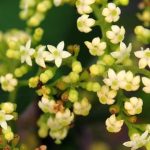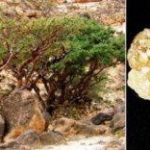TREE LIFE
December 1996
MASHONALAND CALENDAR
Tuesday 3rd December: Botanic Garden walk at 4.45 for 5 p.m. We will meet Tom in the public car park of the Gardens. This month Tom will show us creepers, climbers and lianas; it is amazing how many there are in the Gardens.
Sunday 8th December: Nick and Sue Fawcett have very kindly offered us a wonderful venue for our Christmas social/tree walk. Manzou is a private game park situated in the Mazowe Citrus Estates. Apart from an abundance of game Manzou also has a tree sanctuary containing many species of trees, most of which are labelled. The perfect place for Tree Bingo. So bring your lunch and a little Christmas fare for a pre-Christmas get-together. If it rains there is shelter in the form of a large car port. Sorry, for obvious reasons no pets.
Saturday 4th January: Mark’s Walk will be held in early January, once again at Lyndhurst Farm. This time we plan to walk down the Ruwa River below the dam wall. This is a very interesting habitat with rocky places, stream banks, marshes and vleis and some thick riverine bush containing unusual creepers and climbers.
Tuesday 7th January: Botanic Garden Walk.
MATABELELAND CALENDAR
Sunday 1st December: Visit to Brownlee Walker’s farm. All day visit. Meet at Girls’ College as usual – 8 for 8.30 a.m. departure.
Monday 9th December: Study Session
Urban trails in Circular Drive area. Meeting at 5-5.15 p.m. These sessions will take place on the second Monday of every month on a regular basis.
New Year’s Social Do: Possibly at Clem Van Vliet’s or at Mabukuwene Aloe Garden.
Sunday 5th January 1997: Trip to Khamera near Khami ruins to find Erythrophysa and Adansonia digitata.
BOTANIC GARDEN WALK 5 December 1996
21 members assembled in the car park to hear Tom finish off last month’s subject, Hippocratea, and to start this month’s, which was Strychnos.
Firstly, Apodostigma pallens, an enormous liana, very rare in evergreen low-altitude rainforest. Tom mentioned that he had seen it along the Chisengu river in the Haroni/Rusitu confluence area and possibly also in the Burma Valley. Loeseneriella africana var. richardiana is another liana, this time with a remarkably fluted stem. This is one of the main lianas in the Chirinda Forest climbing by modified side-branches. Unlike Apodostigma and the next species, this is not confined to the Eastern Division but has been widely recorded from low altitudes.
Simirestis goetzei is yet another liana. This has only been recorded once in Zimbabwe, by Tom, from a site in the Burma Valley, where altogether 3 new species were found in a patch of forest. It has bright orange under bark and the outer bark is shallowly peeling.
Next, on to Strychnos. All species of Strychnos are 3-veined from the base, so often the leaves look rather similar even though the life form of each species varies considerably. Strychnos angolensis is a rare species of the Eastern Districts. It is a liana in rainforest, sometimes a gigantic plant. It occurs at low altitudes in the Haroni/Rusitu areas and specifically in tributaries of the Rusitu.
Strychnos mellodora is another rare plant, this time a tree, not a liana. It occurs sporadically in the Chirinda Forest. Tom explained how it is a classical sub-canopy tree, never attaining the height of the tallest trees (although it may still achieve 35-40m) and hence never taking the full sun directly.
A third Eastern Districts Strychnos is Strychnos lucens. Although the specimen in the gardens was shrub-like, because it was young, the mature plants are again huge lianas, bearing their fruits up in the canopy.
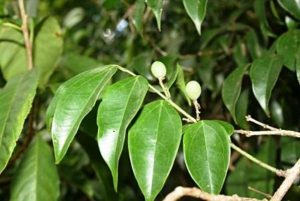
Strychnos usambarensis. Photo: Mark Hyde. Source: Flora of Zimbabwe
Strychnos usambarensis is a plant of the lower understorey (Tom explained how in many forests, for example at Chirinda, there is both a high and a low understorey). The leaves are typically 3-veined from the base, they are rather small compared to other species and they have a long drip-tip. The species is a shrub or small tree. Strychnos mitis is a tree, sometimes extremely large, as, for example at Chirinda. It also occurs in the forest patch on Wedza Great Zimbabwe. The bark is exceptionally thin, c.1 mm.
Two more low altitude species examined were Strychnos henningsii and Strychnos decussata. Strychnos henningsii is a plant of low-altitude outliers, for example the Haroni/Rusitu area. Unlike Strychnos mitis it has very thick bark, c.10-20 mm.
After all these rarities and special plants, it was reassuring to see specimens of familiar Strychnos spinosa and Strychnos potatorum.
Once again, our very great thanks to Tom for an illuminating walk.
-Mark Hyde
TO TOM & MARY RAUB’S KANA ESTATE NEAR GWAYI
On 1st November, ten of us including our host Tom Raub, met at his spread (or one of them) about 230km up the road to Victoria Falls, where we turned right and followed a (good) dirt road 8km to the estate. But first the Falls Road, no longer any connecting feature with that angry one in Ulster, so beautiful, so satisfying to travel. Between the Teak forests – whence comes our best honey – and lined with all those major trees which contribute such glory to some of our roads and depending hugely on one family, the Cassia, so runs the Falls Road. Baikiaea plurijuga, Brachystegia spiciformis and Colophospermum mopane just for example, all subscribe to the same root and stem and especially flower; in fact Ogden Nash could say:
A road where diesels spin, avoid -i ‘ye
Unfringed with Caesalpinioideae.
I am sadly aware that I am unable to aspire to the alliterative lyricism of Norma’s masterly (sorry, can’t really say mistressly) and delightful evocation in our November issue – we’re still gurgling over it – and only wish our October write up had not odiously shamed itself by appearing in the same number.
At our chalet stood a Ficus thonningii with such an eye-catching bole as to fascinate continuously: it was in fact a plaited auto-strangling root system, which had lifted the trunk about 1.5m above the ground, thus attracting much photography.
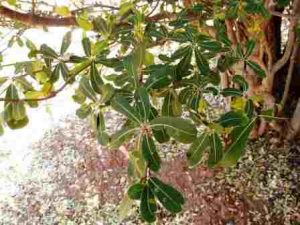
Manilkara mochisia. Photo: Bart Wursten. Source: Flora of Zimbabwe
Evening drinks, I mean sundowners, were on the lawn surrounded by night-apes shining their topaz cufflinks at us from the veritable arboretum about us: notably Diospyros mespiliformis, Manilkara mochisia, Phyllanthus reticulatus with its foretaste of dinner and Terminalia stenostachya – to mention a few.
Appropriately, dwelling on families, there was this festive family feeling about our meals at Tom’s Kana. The right mixture of merry and serious with mounds of delectable food – all Tom’s catering – and the peace of total stillness without, broken only by a breath of Zephyr, which did not prepare us for the night of suffocating heat and tossing insomnia many of us were destined to endure.
However, it made easy the early start planned and after 6 a.m. tea we set off in two Land Cruisers for the Photo-camp passing through fairly dense woodland, much of it as yet unstirred by spring. Yet enough early buds to give a haze of green and some progressive species, of course, had early heard the call and were in full leaf and/or flower. At the photo-camp we broke out of the forest into a spacious vlei with a striking scene of palms (Hyphaene petersiana), was it once Hyphaene benguellensis, with its fruit round or slightly oval? Facing the vlei Tom had built chalets, thatched to the ground, with, so far, accommodation for 8. Attractive structures they are, blending sympathetically with the terrain.
Besides the Hyphaene was a comprehensive catalogue of Acacia with Acacia fleckii outstanding. Some imposing and shapely Combretum imberbe, towering Terminalia sericea and Erythrophleum africanum were featured in and around the vlei. As we penetrated the forest we found clusters of Securidaca longipedunculata – such a nosegay, Albizia anthelmintica and, a novelty for some, Ziziphus abyssinica.
As time wore on, hunger escalated and our leader avowed anorexia, the clay gave way to sand; the girls declared a famine and we were into far-reaching mopane woodland. Toward 9 a.m. intense hunger prevailed and we began our breakfast-ward trail, though not without sporadic stops to view the zebra-bark Commiphora merkeri (now Commiphora viminea). At our all-fulfilling breakfast even the leader was surreptitiously noted to have seconds. Then came the great error of our weekend ways: we set forth at 10.40 hrs for the hunting camp. This was well beyond the photo ditto and perched on the banks of the great Shangani River flowing with unquenchable sand. The midday heat was insufferable and many of us significantly wilted. Through our sweat and tears we dimly acknowledged Ficus sycomorus, Acacia robusta (subsp. clavigera) and, falling into syncope, noted the ground was parqueted with the apple-rings of Faidherbia albida.
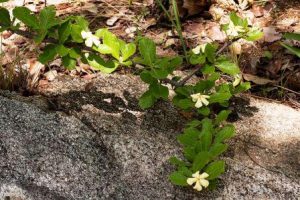
Catunaregam spinosa. Photo: Bart Wursten. Source: Flora of Zimbabwe
As we were slid into the brake on our stretchers, Catunaregam spinosa & Diospyros quiloensis were espied, whilst spikes of yellow shone through our stupor – Cucumis metuliferus again.
Despite cries of siesta we were seduced to eat hamburgers (some were toasted) & a lush salad; where after no blandishments could inhibit our coma. The third foray in one day took the intrepid 10 at 17.00 hrs to the large dam, with its leaking wall (roots ahoy), a spectacular sunset with blitzen and the fumets of a big cat, which we realized with awe, was the droppings of a lion. Felis leo, himself, was doubtless regarding us with disdain from his den. Birds galore – but trees; were we perhaps sated? Certainly not Anthon and Tom, who are insatiable. Acacia gerrardii was not to be disregarded, then wisely the party wended away to dinner, promising another look on the morrow.
Last morning and a 06.15 start with tea and back to the dam. On our early drive down the woody track a goshawk became the flight leader, gliding before us just below eye level for a furlong then soaring to its tree. Notably recorded were Crossopteryx febrifuga, Erythroxylum zambesiacum, Ximenia americana (and a learned member seeking a park bench) and was it really Tacazzea apiculata?
Having eventually extracted Tom and Anthon from the forest the tree people returned to a vast brunch at 10.00 hrs.
Right there in the garden must be mentioned Baphia massaiensis, Schinziophyton rautanenii, Maytenus heterophylla, and Xeroderris stuhlmannii. My total was 91 species but I guess Anon has more up his sleeve. Big thanks to Tom.
-Eric McNair.
BIVINIA JALBERTII
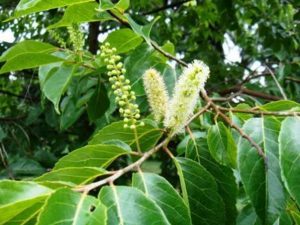
Bivinia jalbertii. Photo: Maureen Silva Jones. Source: Flora of Zimbabwe
One of the very few Zimbabwean trees considered Endangered (the highest of the IUCN threat categories) by Hiram Wild and Tom Muller in a list they made in 1979, is MUTUPUTUPU, the local name for Bivinia jalbertii (sometimes called Calantica jalbertii). This very interesting tree in the Flacourtiaceae family is restricted to a few areas exposed to dry-season mist and drizzle (guti) in the ill-defined Limpopo escarpment region of Chivi, Masvingo and Chipinge Districts.
The genus Bivinia (which has not been sunk under Calantica despite recent suggestions to the contrary) consists of eight species in Madagascar, only one of which occurs on mainland Africa. Bivinia jalbertii Tul., apparently described in 1857 from Madagascar is also found in moist forests near the Kenya and Tanzania coasts, and in the Chimoio area of central Mozambique in “rocky areas”. Unlike many species of the drier evergreen kloof forests in rocky hills at lower altitudes (e.g. Warburgia salutaris), it is not found in South Africa. The interest in Bivinia is not just in its present rarity, but mostly in its potential as a good indigenous construction timber. The trunk is remarkably slender, straight and tall (reportedly up to 30m), producing high quality poles much sought after for rafters. It is also borer-proof and at least somewhat termite-resistant. This has led to it being heavily exploited in the Nyoni Hills above Ngundu Halt in Chivi District, its best-known locality.
Reports from Tom Muller at the Botanical Gardens in Harare suggest that the species is moderately fast-growing but somewhat frost-sensitive. It can flower after 10 years, and makes an interesting garden subject. The experiences of Alan Sparrow and others, growing Bivinia in gardens and on farms in Bulawayo and Chiredzi, show a similar story – a species easy to germinate and establish, quite fast growing, able to coppice and without any real cultivation problems. Quite a nice tree to have around, in fact.
The fear of over-exploitation of a species with a very restricted distribution was probably the motivation behind the proclamation of the Nyoni Hills indigenous Forest Reserve in 1941 under the Tribal Trust Land Forest Produce Act (reaffirmed by Government Notice No.484 of 1959 under the Native Reserves Forest Produce Act), which prohibited cutting of any tree in this 784.5 ha area, except under permit. This protection did not seem to have the desired effect, perhaps owing to the great difficulties in enforcing such regulations and the lack of suitable construction timber in the surrounding areas, and trees were still being cut in the late 1970’s. Trevor Gordon reported in 1970 that he did not see any regeneration, and only few mature trees remained.
It was in the mid-1970s that efforts were made to establish Bivinia in plantations – in modern parlance, ex situ conservation. Seed was collected from a wooded ravine in the south-eastern part of the Nyoni Hills near Headman Gororo’s kraal by “Tackie” Bannermann, the Agricultural Officer for Victoria Province, and around 100 nursery-raised seedlings were planted out in the small-scale Banga irrigation scheme to the north in 1977. Alan Sparrow and others collected seed from the same locality in 1978, and the following season seedlings (about 60-80cm high) were distributed to the Lowveld Agricultural Research Station at Chiredzi, Hippo Valley Estates and Triangle Sugar Estates. The plants at Hippo Valley soon died, but those at Chiredzi and Triangle established and grew well (albeit under good conditions and with irrigation), averaging 1.5m height growth per annum over the following few years. A small number of seedlings were also “reintroduced into the wild” in a suitable wooded ravine in what was then Zimbabwe National Park (now Great Zimbabwe Ruins) not far away. It is not known if they still survive.
There are reports, or perhaps it is just speculation, on the occurrence of Bivinia in similar wooded ravines of gneiss around Lake Bangala, some 30km to the northeast of the Nyoni Hills. It is certainly a similar environment with winter mists and drizzle where the oceanic air starts to rise against the broken, shallow ramparts of the Limpopo escarpment. Recently, Steven Mavi of the National Herbarium has found the species in Mhungura forest in Chipinge ‘A’ Safari Area. Here, it is surprisingly on west-facing slopes in a gully, away from the direct influence of winter guti. Further exploration may well yield other similar localities.
When the Tree Society visited the Nyoni Hills in April 1994 only one coppice plant was seen on the side of the road near the Post Office repeater station on the summit ridge, in fairly dense Brachystegia spiciformis woodland. During the August 1996 Tree Society visit, when we had a fairly good look in suitable localities on the densely-wooded summit ridge, we found only three individuals. One sapling in an open grassy area (due to previous clearing or fire?) near the end of the track, and two coppice plants (one about 3m tall) at the same place as it was seen in 1994. A disappointing tally for what was meant to be a locally common species. But on reflection, perhaps a better place to look would have been the steep rocky slopes with Androstachys johnsonii overlooking the gorge at the eastern end of the hills where it is proposed to build the Tokwe Dam to provide irrigation water for the sugar estates downstream. Both Alan Sparrow and Tom Muller have found it in the lower portions of wooded ravines, approached from the base of the hills, but these trees are also, of course, more accessible to cutters.
Considering how interesting and potentially valuable Bivinia is, we know surprisingly little about it.
Has the species, the conservation of which has been specifically legislated for under various Acts, really almost disappeared from its old haunts? Do reasonable populations exist on ranchland around Bangala Dam? Are the Nyoni Hills worth adding to the priority sites for botanical conservation in the country? Hopefully a future Tree Society trip will give us some answers.
-Jonathan Timberlake Bibliography supplied
MSASA FARM. 20 OCTOBER 1996.
These kopjies are well known to a number of Tree Society members when in February 1993 thirty soaking people took refuge under a small overhang of rock jutting out from the mass of granite known locally as the Sugar Loaf. Some rock paintings occur here with a few different features but also the variation in vegetation is worth considering, from Msasas along the valley which the dam now occupies to the more sandy conditions around the dam wall where Parinari and Faurea seem to be locally dominant. Some epiphytic orchids, often an indicator of moist conditions also occur here.
The tree species here are typically those found on the highveld, one of the commonest being Burkea africana complete with the rusty coloured growing tips and pale yellow/white flowers on long dangling racemes. Being frequently infested with caterpillars, although we saw none today, gives Burkea the traditional name of Mukarati, meaning many worms. The Gardenia ternifolia whose spectacular sweet scented blooms awoke many travellers to its presence around the country, have withered. But something else now benefits from the blossom, a ‘mother’ tip-wilter tending her nursery and the red coloured youngsters head up the stems to suck the juices from the newly formed ovaries. Well ahead of Christmas, the Christmas Berry Psorospermum febrifugum appeared with small clusters of white blooms tucked closely in between the terminal leaflets. This tree has a curious traditional use in addition to the bark and roots providing a general cure-all for diarrhoea, earache and constipation. Should powder from ground up roots be found scattered on a husband or wife’s clothing discord between the couple will occur and for the same reason cutting of the tree is also frowned upon in traditional society. Other species around this spot with human uses are Ozoroa insignis, the roots being used widely for abdominal pains and diarrhoea while the bark is used to treat constipation as well as being an aphrodisiac, the results of a misdiagnosis must be quite severe. Lannea discolor has edible fruit when ripe and the bark fibre used as a wound dressing – a ‘low tech’ Elastoplast. The Tree Society occasionally has spurts of energy, today being one of them when the mention of a few Bushman paintings on the lower face of the Sugar Loaf transformed our amble into a straggle dragging its way up a steep incline using Commiphora mossambicensis, Pouzolzia mixta and Euphorbia matabelensis (kindly named by Phil as a zigzag tree) for both moral and physical support. The paintings depict a few unusual features including a figure resembling a small twisted serpent and a lactating dog with large ears. The rest of the work contains the usual collection of figures, a few obscured by a stunted Ficus natalensis sporting the typical truncated leaves of the species as well as others that resembled Ficus thonningii, all carefully positioned to frustrate those already overheated with the stiff climb. Along cracks and fault lines Garcinia buchananii were found, with a solitary Rothmannia fischeri showing the first signs of buds and on the steep slopes in typical rocky habitat many Brachystegia glaucescens, one having the most amazing contortions to its branches.
Leaving the main party under the expert guidance of Phil I headed back to ‘rescue’ Ann and Joan who waited further down. Skirting the kopjie from the shallow side, a superb Ficus sycomorus above the canopy of Msasas provided a welcome patch of cool shade, with an unexpected find of a large clump of Leopard orchids – Ansellia africana nearby. From our leafy lair we couldn’t quite see from where, but high above in the kopjie the incessant calling of a Tchagra added to the restless sounds of October.
Alongside the newly prepared tobacco lands the white flowers of Scabiosa columbaria grew, the plants attempting to colonise the disturbed soil. Occurring in grassland was one of the low-growing members of the Ochna family namely Brackenridgea arenaria. This plant had intrigued us on the recce but unfortunately the delicate pale pink blooms had long since withered leaving only the largish leaves. Another plant in the same patch were a scattered colony of a tiny Helichrysum caespititium and growing along the roadside Monsonia burkeana bearing the most delicate pale pink flowers and diagnostic long spiked fruits of the geranium family. Within the woodland around the lands some of the Protea family occur and include Faurea rochetiana (Faurea speciosa for the doubting Dennisons), Faurea saligna, Protea angolensis and Protea gaguedi. The Garcinia buchananii down here produce fruit in profusion which despite being hard and green, gave Ann Bianchi ideas of pitching a tent in their shade to keep the baboons away from the feast. These are a highly prized woodland delicacy when ripe and the seeds are difficult to find. One of the great delights today were the Strychnos spinosa whose branches were literally pulled down by the heavy crop of cricket ball sized fruit. The first trees encountered contained the usual brown gooey inside, slightly stringent but most refreshing. Various fingers waggled at me and voices sagely warned about excessive consumption but those of us who went wild over the fruit bore no ill effects, sorry! A most enjoyable day and to our surprise the resident baboon troop made no fuss at all, perhaps our botanical bumbling posed no threat.
Many thanks indeed to the Coleman family for another visit and to Phil for leading the walk.
-Andy MacNaughtan
FLORA OF HARARE AND CENTRAL ZIMBABWE: PROGRESS REPORT 2.
Since the last report in Tree Life 170 (April 1994), work has continued steadily, although rather slowly. More trips have been made with Maureen Silva¬Jones and Andy McNaughton to the fascinating world of the Sanyati Communal Land and every time more species have been added to the Central Division. The other fruitful source of new species is weeds and garden escapes, not surprisingly most of these arising around Harare.
Species added to the Central Division are as follows. Weeds and casuals are preceded by an asterisk.
*Acacia dealbata / Acacia mearnsii
Acacia mellifera
Asystasia schimperi
Barleria prionitis ssp. ameliae
Basilicum polystachyon
Boscia mossambicensis
Commiphora ugogensis
Commiphora viminea (merkeri)
Corchorus olitorius
Cordia mukuensis
Crossandra spinescens
Ctenolepis cerasiformis
Cyathula orthacantha
*Desmodium triflorum
Desmodium ospriostreblum
Deverra burchellii
Dicoma tomentosa
Eragrostis congesta
Faidherbia albida
Fockea angustifolia
Fockea multiflora
Heliotropium strigosum
Hibiscus sidiformis
Hybanthus enneaspermus
Hygrophila auriculata
Justicia odora
Lepidagathis scabra
*Ligustrum sp. (deciduous)
Macroptilium urbanianum
*Michelia champaca
Nemesia zimbabwensis
Olax obtusifolia
Paederia bojeriana ssp. foetens
*Phytolacca dioica
*Plectranthus barbatus
*Populus deltoides
Portulaca foliosa
Portulaca quadrifida
Pterodiscus elliottii
*Rosa sp.
*Solanum tuberosum (Potato!)
*Tipuana tipu
Triaspis macropteron ssp. massaiensis
Triumfetta pentandra
*Tulbaghia sp.
Vernonia steetziana
Wissadula rostrata
In addition to the 47 species on this list, there were the casuals that appeared along the verge at Glenara Avenue South this year, a number of which are probably new and some of which remain unidentified.
I should add that in claiming the species in the list above as new, I have relied on the published literature and in most but not all cases the absence of Central Division specimens at the National Herbarium. Others may have known of some of these species. For example, the Olax was found on the Tree Society outing in March but was already known by Ann Bianchi in the Chegutu area. Once again, I would like to thank Bob Drummond for naming so many of these plants for me.
-MARK HYDE.
ANDY MACNAUGHTAN CHAIRMAN


